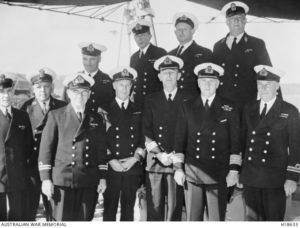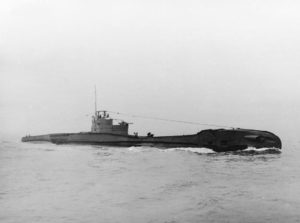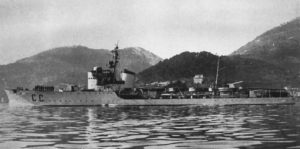- Author
- A.N. Other
- Subjects
- Biographies and personal histories, WWII operations, History - WW2
- Tags
-
- RAN Ships
- HMAS Stalwart I, HMAS Oxley I
- Publication
- June 2021 edition of the Naval Historical Review (all rights reserved)
A colleague from the United Kingdom conducting research into wartime submarine losses recently contacted the Society seeking information on the Australia- born captain of HMS Tempest which was lost in the Mediterranean in February 1942. This gives rise to the following intriguing story of the brothers Cavaye.
The Cavaye clan hail from Scotland, where members of the family feature in the military history of Empire. As a twenty-year-old seeking adventure Frederick Napier Warden Cavaye came to Australia and worked on properties in Queensland. Here he met, and in 1886 married, Emily Hatfield, from an established pastoral property. This happy union produced two sons and four daughters. Frederick prospered and eventually became a partner in the large pastoral properties of Langton and Logan Downs.
As teenagers the sons, Frederick Langton Cavaye and William Keith Napier Cavaye, were sent to England for schooling and both later entered the Royal Navy (RN). Being Australian born, the elder son may have entered the RN under a colonial cadetship but by the time his younger brother joined this type of advantageous entry was no longer available.
Frederick Langton Cavaye (1891-1979)
As an early entry into the RN Frederick served at both Osborne and Dartmouth naval colleges. Following sea time with the fleet, Sub Lieutenant Cavaye was lent to the Royal Australian Navy (RAN) as part of the commissioning crew of the light cruiser HMAS Sydney (I) and was in her during the famous battle with SMS Emden. In 1915 Lieutenant Cavaye reverted to RN service and began a remarkable career with numerous commands.
He was again lent to the RAN in command of the destroyer HMAS Stalwart (I) from 1919 to 1922. On 27 April 1922, at a society wedding at Brisbane’s St John’s Cathedral presided over by Archbishop Le Fanu, he married Miss Joan Condamine Taylor, from the well-known Bellevue Station. Amongst the guests were the State Governor Sir Matthew Nathan and Lady Helena Rous, Major General Sir Julius Bruche, GOC Queensland, and the Fleet Commander, Rear Admiral John Saumarez Dumaresq. Afterwards the bride and groom returned to Sydney where they boarded the P&O liner Narkunda for passage to England, where the Commander continued his naval career.

Frederick Cavaye’s naval career included eleven seagoing commands, admittedly some of short duration. This did not start well with his first command sunk by a submarine and, within a matter of months, another command sunk in a collision for which he was not blamed. This run came to an end in 1934 when he resigned at his own request and was placed on the Retired List as a Commander.
The family returned to Australia, and during this interlude Commander Cavaye was posted to HMAS CerberusFrederick Cavaye’s naval career included eleven seagoing commands, admittedly some of short duration. This did not start well with his first command sunk by a submarine and, within a matter of months, another command sunk in a collision for which he was not blamed. This run came to an end in 1934 when he resigned at in September 1937 for 14 days training. With the outbreak of war Commander Cavaye entered the RAN on the Emergency List and was initially posted to the depot and accommodation ship HMAS Penguin, then berthed at Garden Island. He was soon posted as Officer in Charge Newcastle NSW and then started a series of shore commands including HMA Ships Penguin, Rushcutter and Moreton. He also served briefly as Commodore of Convoys. With the end of hostilities his appointment was terminated on 19 October 1945 when he reverted to the Royal Navy Retired List. And so ends the amazing naval career of this remarkable officer who held in total 14 commands, both ashore and afloat, which may possibly be a record.
William Keith Napier Cavaye (1906-1942)
Following in the footsteps of his older sibling, the younger brother entered the Britannia Naval College on 2 July 1918.As a midshipman he served in the battleship HMS Valiant and the battlecruiser HMS Renown. Following Sub Lieutenant courses at Greenwich he volunteered for submarines, serving in a number of boats, mainly operating from Portsmouth.
The submarines Otway and Oxley had been presented to the RAN in February 1928, but after a lengthy voyage they did not arrive in their new homeland until 1929. Due to economic problems caused by the Great Depression they were soon laid up and it was decided that they should be returned to the RN. Lieutenant Cavaye was posted to our shores as navigator of HMS Oxley which recommissioned on 10 April 1931 for her return voyage to England.
In 1933 he was First Lieutenant of HMS Otus on the China Station and in 1935 undertook the Commanding Officers Course (Perisher). The next year he received his first command, that of HMS Snapper serving in the Mediterranean. From 1937 to 1939 Lieutenant Commander Cavaye reverted to the surface fleet serving in the cruiser HMS Orion on the America and West Indies Station.
In August 1939 he returned to submarines in command of the Reserve Group ‘F’ with the 5th Submarine Flotilla. In October 1939 he was appointed in command of the submarine HMS H43, and later received commands of the submarines Ursula and Tribune before being appointed to command of HMS Tempest on 8 October 1941.
HMS Tempest
In early 1942, offensive operations from Malta were confined to the small 630-ton U-class boats of the 10th submarine flotilla. The flotilla suffered increased numbers of losses, mainly due to the use of German sonar sets which from late 1941 were being supplied to Italian escort vessels.
HMS Tempest was a larger 1,300-ton boat of the T‑class which was assigned to the 1st submarine flotilla based at Alexandria. She was now on her second patrol with two other boats from Alexandria making for the Gulf of Taranto. Her captain Lieutenant Commander William Cavaye was an Australian born career officer who had joined the Royal Navy from school. In comparison with many other freshly minted submariner commanders of this time he was experienced and well trained.

Tempest had the misfortune to be discovered by the Italian Regia Marina1 Spica-class torpedo boat RN Circe2 on 13 February 1942. Her commanding officer Capitano di Corvetta (LCDR) Stefanino Palmas had attended Kriegsmarine ASW courses and had received further consolidation training in Italy. On this mission Circe was escorting the German merchantman Bosforo to Taranto. Extra care was being taken as the day before in these waters the submarine HMS Unahad sunk the Italian tanker Lucania, which had been granted immunity by the Admiralty as she was helping rescue refugees from East Africa. In a feeble excuse it was afterwards revealed that Una’s commanding officer Lieutenant D. S. R. Martin, being unwell, had not read his signals before leaving Malta3. The Italians were incensed at this lack of compassion.
Two experienced commanders in relatively new and well-prepared vessels were thus set against one another in this time of tension. In darkness at about 3.00 am on 13 February 1942, with the submarine on the surface, both vessels simultaneously detected one another. Cavaye opted for a surface torpedo attack while Palmas went for full power and made to ram. As the two vessels rapidly closed Cavaye changed his mind and ordered an emergency dive. Circe’s sonar operator was able to detect the submarine’s klaxon and maintain contact with her as she went deep. At about 3.30 am the first set of depth charges were released which caused some damage to the submarine’s structure and electrical supplies. While maintaining contact Palmas decided to call off the attack until daylight. As a result, at about 7.16 am Circe resumed the attack which found its target as oil and bubbles came to the surface. This led to a third and final attack with the last of her depth charges which mortally wounded her prey, with flooding and the escape of chlorine gas from broken batteries. At 9.45 am Tempest was obliged to surface, when the captain ordered abandon ship. As the crew scrambled over the casing some appeared to be making for her deck gun, leading Circe to open fire, causing more damage, injuries and further loss of life.
The gun engagement did not last long as the submarine crew threw themselves into the water. In difficult sea conditions Circe rescued as many as possible, sending over a boarding party to salvage confidential material, but code books had already been jettisoned in a weighted bag, they then attempted to tow the submarine to safety.
Eventually 23 survivors from Tempest’s complement of 61 were brought safely ashore, many are thought to have drowned because of the poor quality of the life jackets then available. Tempest did not survive the 30-mile journey and sank beneath the waves. Lieutenant Commander William Cavaye was killed in this action.

Circe, which had remarkably now sunk four Royal Naval submarines, gained a reputation as a fearsome submarine hunter and Capitano di Corvetta Stefanino Palmas received the Silver Military Medal for Valour. Not many months later, on 27 November 1942 on an escort mission a manoeuvring error caused her to be accidentally rammed by the auxiliary cruiser Citta di Tunisi. The gallant little Circe was cut in two and sank within minutes taking Captain Palmas and another 65 men with her out of her 116 strong crew.
Notes:
- Before 1946 the Italian Navy was known as the Regia Marina or Royal Navy and the prefix for its ships was RN.
- The impressive Spica-class of 32 ships were built between 1934 and 1937. Circe is credited with sinking four Royal Navy submarines HM Ships Grampus, Union, P38 & Tempest.
- Lieutenant Martin was relieved of his command and after hospitalisation was flown to England to explain his actions. He later received another submarine command in Home waters.
References:
Australian newspaper articles found in Trove.
Biermann, Andreas, The Crusader Project website, 2020.
Fox’s History of Queensland 1919-1923, Vol 2C, State Publishing Company, Brisbane, 1923 – available online.
Stefanino Palmas and the torpedo boat Civic, Marina Militare website, 2021.
White, Michael, Australian Submarines: A History, Australian Teachers of Media, Melbourne, 2015.




